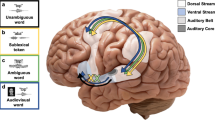Abstract
To examine the role of motor areas in speech perception, we carried out a functional magnetic resonance imaging (fMRI) study in which subjects listened passively to monosyllables and produced the same speech sounds. Listening to speech activated bilaterally a superior portion of ventral premotor cortex that largely overlapped a speech production motor area centered just posteriorly on the border of Brodmann areas 4a and 6, which we distinguished from a more ventral speech production area centered in area 4p. Our findings support the view that the motor system is recruited in mapping acoustic inputs to a phonetic code.


Similar content being viewed by others
References
Liberman, A.M., Cooper, F.S. Shankweiler, D.P. & Studdert-Kennedy, M. Psychol. Rev. 74, 431–461 (1967).
Rizzolatti, G., Fogassi, L. & Gallese, V. Curr. Opin. Neurobiol. 12, 149–154 (2002).
Binder, J.R. et al. Cereb. Cortex 10, 512–528 (2000).
Scott, S.K. & Wise, R.J.S. Cognition 92, 13–45 (2004).
Benson, R.R. et al. Brain Lang. 78, 364–396 (2001).
Callan, D.E. et al. Neuroreport 14, 2213–2218 (2003).
Bookheimer, S. Annu. Rev. Neurosci. 25, 151–188 (2002).
Fadiga, L., Craighero, L., Buccino, G. & Rizzolatti, G. Eur. J. Neurosci. 15, 399–402 (2002).
Watkins, K.E., Strafella, A.P. & Paus, T. Neuropsychologia 41, 989–994 (2003).
Geyer, S. et al. Nature 382, 805–807 (1996).
Geyer, S. The Microstructural Border Between the Motor and the Cognitive Domain in the Human Cerebral Cortex (Springer, Berlin, 2004).
Fox, P.T. et al. NeuroImage 13, 196–209 (2001).
Ehrsson, H.H., Geyer, S. & Naito, E. J. Neurophysiol. 90, 3304–3316 (2003).
Blumstein, S.E., Baker, E. & Goodglass, H. Neuropsychologia 15, 19–30 (1977).
Schubotz, R.I. & von Cramon, D.Y. NeuroImage 20, S120–S131 (2003).
Acknowledgements
We thank K. Amunts for providing cytoarchitectonic maps, the UCSD Center for Functional MRI, and the Ahmanson-Lovelace Brain Mapping Center. Supported by NSF grants REC 0107077 and BCS 0224321.
Author information
Authors and Affiliations
Corresponding author
Ethics declarations
Competing interests
The authors declare no competing financial interests.
Supplementary information
Supplementary Table 1
Areas activated by listening to speech in six or more subjects, and motor areas activated by producing speech or bimanual movement. (PDF 22 kb)
Rights and permissions
About this article
Cite this article
Wilson, S., Saygin, A., Sereno, M. et al. Listening to speech activates motor areas involved in speech production. Nat Neurosci 7, 701–702 (2004). https://doi.org/10.1038/nn1263
Received:
Accepted:
Published:
Issue Date:
DOI: https://doi.org/10.1038/nn1263
- Springer Nature America, Inc.
This article is cited by
-
Auditory-motor synchronization and perception suggest partially distinct time scales in speech and music
Communications Psychology (2024)
-
Dynamic causal modeling analysis reveals the modulation of motor cortex and integration in superior temporal gyrus during multisensory speech perception
Cognitive Neurodynamics (2023)
-
Longitudinal changes in cortical responses to letter-speech sound stimuli in 8–11 year-old children
npj Science of Learning (2022)
-
FMRI-based identity classification accuracy in left temporal and frontal regions predicts speaker recognition performance
Scientific Reports (2021)
-
Motor engagement relates to accurate perception of phonemes and audiovisual words, but not auditory words
Communications Biology (2021)





